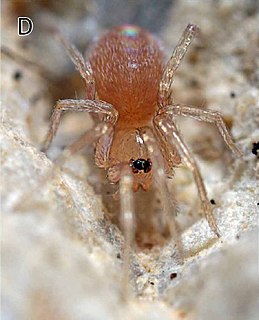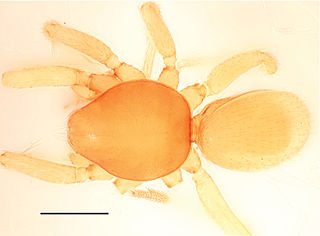
Oonopidae, also known as goblin spiders, is a family of spiders consisting of over 1,600 described species in about 113 genera worldwide, with total species diversity estimated at 2000 to 2500 species. The type genus of the family is OonopsKeyserling, 1835.

Norman Ira Platnick was an American biological systematist and arachnologist. At the time of his death, he was a Professor Emeritus of the Richard Gilder Graduate School and Peter J. Solomon Family Curator Emeritus of the invertebrate zoology department of the American Museum of Natural History. A 1973 Ph.D. recipient at Harvard University, Platnick described over 1,800 species of spiders from around the world, making him the second most prolific spider taxonomist in history, behind only Eugène Simon. Until 2014 he was also the maintainer of the World Spider Catalog, a website formerly hosted by the AMNH which tracks the arachnology literature, and attempts to maintain a comprehensive list, sorted taxonomically, of every species of spider which has been formally described. In 2007 he received the International Society of Arachnology's Bonnet award, named for Pierre Bonnet, in recognition of his work on the catalog.

Unicorn ("one horn", in Latin) is a genus of goblin spiders from South America, containing seven species that occur predominantly in high elevation, semi-desert regions of Bolivia, Chile, and Argentina. Individuals are relatively large for goblin spiders, measuring up to 3.0 mm (0.12 in) in body length. The genus name refers to a characteristic pointed projection between the eyes and jaws of males. In at least one species, broken-off tips of the male pedipalps have been found within the genitalia of females, postulated as a means of sperm competition. Unicorn possesses several traits that suggest it is a relatively "primitive" member of the Oonopidae, and is classified with other similar, soft-bodied goblin spiders in the subfamily Sulsulinae.

Triaeris stenaspis is a species of spider in the family Oonopidae, with a pantropical distribution. It is also found in Iran and has been introduced into Europe. A very small spider, with a maximum body length of under 2 mm (0.08 in), it has been shown to prey successfully on springtails. Only females have ever been found, and the species may be parthenogenetic, being able to produce female offspring from unfertilized eggs.
Triaeris macrophthalmus is a species of spider from the family Oonopidae. It was described by Lucien Berland in 1914 and is endemic to Tanzania. In 2012, Norman I. Platnick and co-authors described the genus Triaeris as "an enigma wrapped around a mystery". They consider that most species assigned to the genus following Simon in 1890 and before 2012 do not belong to Triaeris, including T. macrophthalmus, which they suggest belongs to one of a group of related genera. As of April 2016, no alternative generic assignment has been accepted by the World Spider Catalog.
Prethopalpus attenboroughi, or Attenborough's goblin spider, is a tiny spider named after Sir David Attenborough, that is found only on Horn Island off northern Queensland in Australia. The millimeter-long spider was described in 2012 by Dr Barbara Baehr of the Queensland Museum and Professor Mark Harvey of the Western Australian Museum.
Prethopalpus is a spider genus known as goblin spiders and are found in the Australasian tropics, including Nepal, India, Indonesia, Papua New Guinea and Australia. Three species are widely distributed, whereas the majority of species are recorded a single localities. Of the 41 species, 14 blind troglobite species live in subterranean ecosystems in Western Australia.
Prethopalpus maini is a subterranean goblin spider in the family Oonopidae.
Predatoroonops is a genus of goblin spiders endemic to the Brazilian Atlantic Forest. The genus is characterized by the extremely modified male chelicerae and long pairs of ventral spines. It is the first fully revised endemic Brazilian genus of spiders, uncovered in 2012 after two and a half years of research at São Paulo's Instituto Butantan.
Tridysderina is a genus of Ecuadorian goblin spiders that was first described by Norman I. Platnick, L. Berniker & A. B. Bonaldo in 2013.
Prethopalpus marionae is a litter-dwelling goblin spider in the family Oonopidae.

Bannana is a genus of goblin spiders native to Xishuangbanna prefecture, Yunnan Province, China, where it lives in the leaf-litter of tropical rainforest. There are two known species: Bannana crassispina and B. parvula, both described in 2015. Individuals are pale yellow and unpatterned, and range from around 1.0 to 1.8 mm in body length, with females being slightly larger than males. The eyes are reduced or entirely absent. Known only from a nature reserve in Xishuangbanna, Bannana belongs to a group of Asian goblin spiders known as the "Dysderoides complex", that ranges from China to Pakistan and south to Indonesia.
Calculus bicolor, the sole species of the genus Calculus, is a South African spider in the family Orsolobidae. Individuals are 4 mm in length, although only juveniles have been described. The abdomen is pale yellow with a broad brown patch, and black markings on the sides of the spinnerets. Calculus bicolor was described by 1910 by William F. Purcell, and long assigned to the Oonopidae, until a 2012 study assigned Calculus to the family Orsolobidae on the basis of sensory organs that differed those of oonopids.
Xiombarg plaumanni is a species of goblin spider occurring in southeastern Brazil and adjacent Argentina. It is the only species in the genus Xiombarg. Italian arachnologist Paolo Marcello Brignoli described X. plaumanni in 1979, naming the genus after Xiombarg, a character in Michael Moorcock novels.
Dalmasula is a genus of goblin spiders containing five species occurring in Namibia and South Africa. Males range from 1.7–2.8 mm in length, females 2.2–3.1 mm. The cephalothorax is orange or yellow, and the abdomen is white.

Megaoonops is a genus of goblin spiders first described by Michael Saaristo in 2007. As of February 2019, it contains only one species, Megaoonops avrona.
Vientianea is a monotypic genus of Laotian goblin spiders containing the single species, Vientianea peterjaegeri. It was first described by Y. F. Tong & S. Q. Li in 2013, and is only found in Laos.

Xyphinus is a genus of goblin spiders that was first described by Eugène Louis Simon in 1893.
Barbara Baehr is a research scientist, entomologist, arachnologist, and spider taxonomist. She has described over 400 new spider species, mostly from Australia. She is originally from Pforzheim, Germany.
Puan is a genus of South American goblin spiders first described by M. A. Izquierdo, N. Ferretti & G. Pompozzi in 2012. As of April 2019 it contains only two species.






